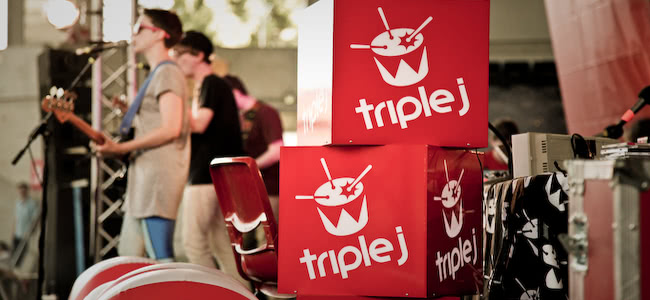Nearly every music fan can agree that Triple J has a huge influence on Australian music, but the more interesting topic of debate is whether the national youth broadcaster’s affect is positive or negative.
With the station’s iconic Hottest 100 countdown just around the corner, it’s a timely question that Fairfax media have asked in a report that questions whether Triple J can be blamed for the ‘sameness’ of new Australian music.
Exploring the suggestion that musicians are deliberately manufacturing a sound to get played on Triple J, fast-tracking their way to national attention and success, Fairfax interviews a number of Aussie music-makers – most who wish to have their identity kept secret – who share the opinion that Triple J has caused the homogenisation of emerging Australian music.
Speaking about the station’s perceived bias towards certain styles of music and sounds that cater to their 18-24 year old age demographic, one anonymous 27-year-old ‘popular’ musician admits to chasing airplay by following a blueprint of “is Triple J going to like this?” during the songwriting process.
“It definitely affects bands Australia-wide,” he tells The Age; “it really is shit, it really is frustrating. I talk about this with nearly every musician friend that I’ve got that there’s no other station that’s up there with Triple J.” “It shouldn’t be this dictatorial thing where you’re not even allowed to criticise Triple J because that’s bullshit.”
Another anonymous interviewee, described as a “respected 26-year-old Sydney” female, describes a perceived fear of Triple J amongst bands and music industry, concerned that it’s influence in breaking emerging talent has lifted them above criticism.
Recalling an article in which she spoke out about the idea of needing a ‘Triple J sound’ in order to get played, the musician recalls; “Once this got published our publicist rang up and screamed, ‘What the f— have you done, you’ll never get played on Triple J again!’… It shouldn’t be this dictatorial thing where you’re not even allowed to criticise Triple J because that’s bullshit,” she says.
Love Music?
Get your daily dose of metal, rock, indie, pop, and everything else in between.
One artist that does go on record is Melbourne MC Al Murray, better known as Illy, who applauds Triple J’s support of Aussie hip hop as reflecting the station’s broader commitment to supporting and developing emerging music that falls outside commercial spheres of radio play.
“I don’t know if I’d ever be able to have a music career if it wasn’t for the station and their support of grassroots Australian music,” says Illy. “Triple J supported Aussie hip-hop and as a result the scene became more than a scene, it really became a legitimate genre in its own right in the mainstream.”
Another two key examples of Triple J’s ability to engender crossover success can be evidenced in Flume and Tame Impala scooping the recent ARIA Awards. Though their multiple wins have everything to do with the quality and successful spread of their music both nationally and internationally, it’s perhaps no coincidence that both groups found popularity with Triple J in the early days of their careers.
While getting airplay on the ABC broadcaster isn’t the only path to exposure for emerging artists – the importance of community broadcasters such as FBi, PBS, RRR et al. cannot be understated – many Australian musicians see it as a major stepping stone for national radio exposure, especially compared to commercial radio’s severe lack of support for Australian content.
In response to criticisms that Triple J is creating a ‘sameness’ in new Australian music, Unearthed Music Director Dave Ruby Howe says that bands purely chasing airplay will nturally get caught out.
Though he admits that of the 600-ish new songs uploaded to Triple J Unearthed, there are similar sounds – such as the “Flume effect that’s inspired a lot of new electronic producers as well as the Queensland garage scene championed by bands like Bleeding Knees and Dune Rats,” – he says that copycats are easier to filter. “People can get frustrated with Triple J if we’re not adding their acts to high rotation or playing their songs and that goes with the territory – we can’t play everything though.”
“Taking inspiration and influence from other artists makes sense, but when music becomes forced and inauthentic it’s pretty easy to see through it,” he says. “[It’s] a fruitless pursuit and I’d encourage any upcoming artist to continue developing their own style.”
The ‘make or break’ Triple J association is only growing in importance as the station expands its brand and influence. The Government-backed broadcaster already reaches an Australian audience of 1.8 million per week on average (up 200,000 from 2012) and last August conquered the Perth metropolitan ratings, a first for the station airing around 40% Australian content (comfortably above the 25% Government enforced quota).
Then there’s the expansion of the Triple J brand with the acquisition of ABC’s Dig Music last October, which hopes to address some of the issues levelled at the youth-oriented programming of the flagship station and the accusations of homogenisation, Dig’s mission being to provide a destination on the dial for those that have outgrown the 18-24 demographic.
“Triple J unashamedly targets young Australians, and sometimes artists who have a more mature sound may not feature heavily on Triple J,” says Station Manager Chris Scaddan. “Dig will be a chance for plenty more acts to find a regular audience.’’
“People can get frustrated with Triple J if we’re not adding their acts to high rotation or playing their songs and that goes with the territory,” he says. “We can’t play everything though; we’ve got to make editorial decisions and we’re open with artists about that. But the thought that we turn away artists if they criticise us isn’t true. We are always open to discussion and there are countless opinions out there about Triple J.”

































